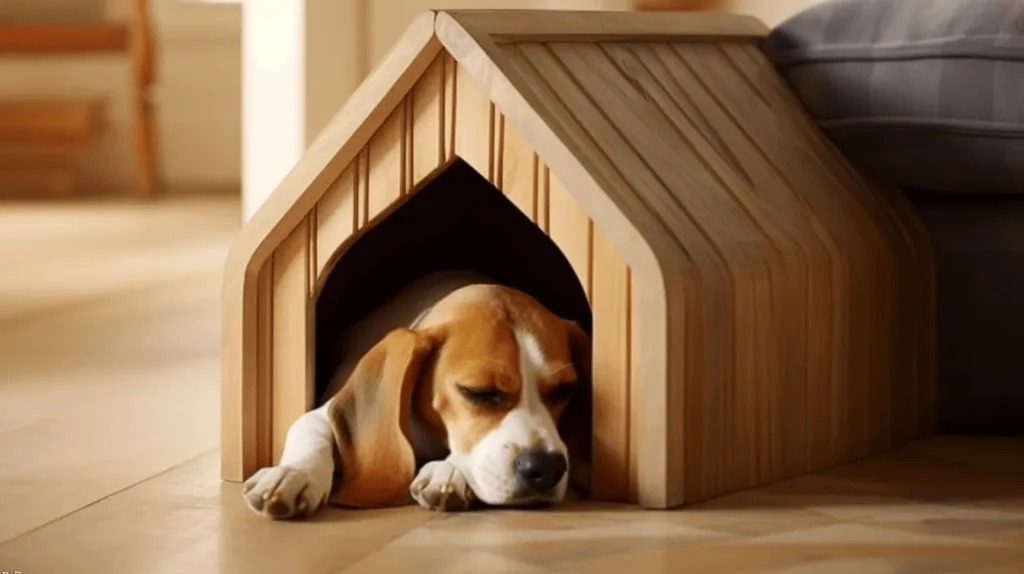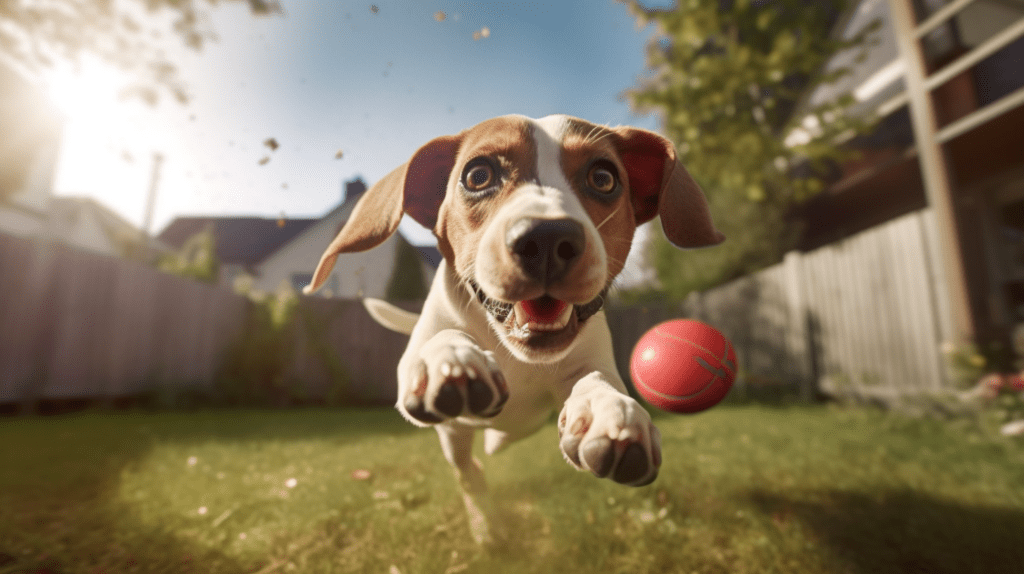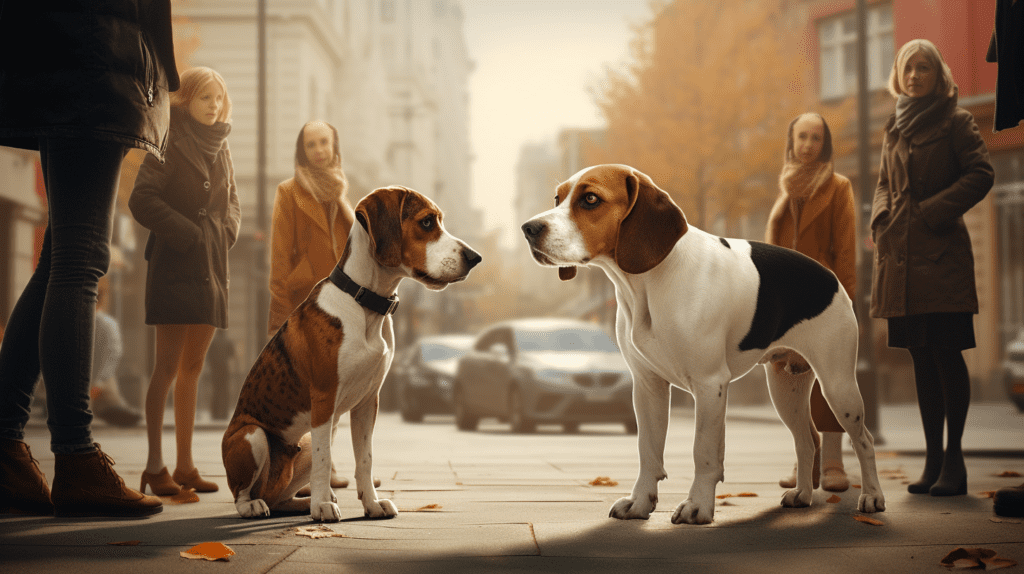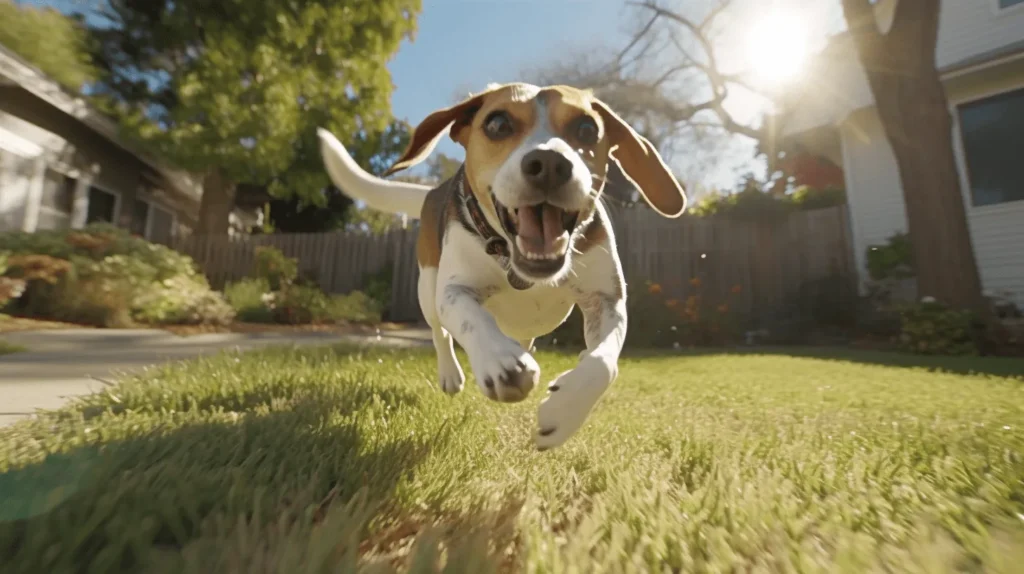When you picture Beagles, it’s often their spirited howls and barks that spring to mind. These are dogs with a reputation for being as vocally expressive as they are energetic. So when your normally chatty Beagle suddenly embraces silence, it’s like a bustling city falling mute – unexpected and a little eerie. So what should you do with your beagle keeping quiet? Let’s first dive into the behavior.
Contents
- 1 Understanding Beagle Behavior
- 2 Health Check: When Silence Signals Something More
- 3 Puppy Quietness: A Rare Phenomenon?
- 4 Training: Could It Be Too Effective?
- 5 Lifestyle Check: What’s Changed for Your Beagle?
- 6 Breed Characteristics and Comparisons: Vocal Traits of Beagles Versus Other Hounds
- 7 Developmental Stages: The Evolution of a Beagle’s Bark
- 8 The Role of Environment: Setting the Stage for Serenity or a Beagle’s Blare
- 9 Owner-Dog Relationship: The Silent Symphony of Companionship
- 10 Body Language: The Unspoken Verses of a Beagle’s Tale
- 11 When to Seek Help
- 12 Embracing the Quiet – For Now
- 13 Sharing the Silence
Understanding Beagle Behavior
Before you start pondering if your Beagle’s vocal cords have taken a sabbatical, let’s dive into the nature of this breed. Beagles are historically hunting dogs, bred to be vocal to alert hunters. A quiet Beagle isn’t the norm, and while it might simply be a case of your dog finding a new hobby in contemplative silence, it could also be an early whisper of health concerns or emotional changes.
Health Check: When Silence Signals Something More
As adorable as a quiet Beagle might seem, it can signal a need for a trip to the vet. These purebred pooches, despite their size, come with a lineage that may carry the weight of genetic conditions. If your Beagle’s silence is accompanied by other signs like lethargy or a loss of appetite, it’s time to turn detective and investigate further.
Puppy Quietness: A Rare Phenomenon?
With beagle puppies, the stakes are different. They’re at the age where energy is as abundant as treats in their dream world. A silent puppy could be a red flag, hinting at something disrupting their normal behavior. It could range from a simple sore throat to more complex issues requiring a breeder or vet’s expertise.
Training: Could It Be Too Effective?


Have you recently trained your Beagle to embrace their inner ‘quiet beagle’? If so, your Beagle might have taken the training to heart. While it’s less likely for a Beagle to be silent out of obedience, it’s not entirely out of the realm of possibility. Training sessions could reveal if this quietness is a newfound discipline or something else entirely.
Behavioral Training Techniques: Composing Quietude in Beagles
When it comes to training a Beagle, one of the most instrumental skills is to teach them the fine art of silence. It’s about conducting a silent symphony while ensuring your Beagle doesn’t mute their essential communications. Here’s how you can strike the right chord:
Positive Reinforcement: The Encore for Silence
- Cue the Quiet: Train your Beagle with a ‘quiet’ command. Start during a bark, saying “quiet,” and the moment they stop barking, even for a breath, reward them. This positive reinforcement is like applauding their performance, encouraging a repeat.
Desensitization: Lowering the Volume Dial
- Steady Exposure: Gradually expose your Beagle to stimuli that trigger barking. Keep them at a distance where they notice but don’t react vocally. Reward calm behavior, and gradually decrease the distance, always rewarding the silence.
Diversion: Changing the Track
- Find a New Rhythm: When your Beagle begins to bark, redirect their attention to a quiet activity like a puzzle toy. It’s the behavioral equivalent of switching from a drum solo to a soothing flute melody.
Scheduled Speaking: Timed Vocal Rehearsals
- Bark Time: Allow your Beagle specific ‘talk times’ throughout the day. During these periods, they can express themselves fully. Then, they’ll be more inclined to hold their tongue, knowing they’ll have a solo later.
Consistency: Keeping the Tempo
- Daily Practice: Consistent responses to barking are key. If a Beagle is sometimes rewarded for barking (even with attention) and other times punished, they’ll be as confused as a jazz musician in an opera. Uniformity is essential.
Environment: Setting the Stage for Silence
- Peaceful Surroundings: A calm environment can influence your Beagle’s behavior. If your household is chaotic, your Beagle may respond in kind. Create a peaceful haven, and your Beagle’s inner volume is likely to match.
Communication: Understanding the Lyrics
- Respond to Needs: Sometimes, barking is simply communication. Ensure that all your Beagle’s needs are met before expecting them to be quiet. If they’re barking at the door, they may need to go out—it’s their way of ringing the bell.
Professional Training: The Master Class
- Seek Expertise: If the barking persists, consider enrolling your Beagle in a professional training class. A dog behavioralist is like a maestro, capable of pinpointing the issues in the canine chorus and bringing it to harmony.
Balancing the silence and barks of a Beagle is much like tuning an instrument—too tight and it will snap, too loose and it will not play. Encourage quiet behavior without stifling their inherent need to express themselves. With these methods, your Beagle can learn when it’s time for a solo and when it’s time to let the orchestra have its moment. This balance ensures that when your Beagle does speak up, it’s a communication worth listening to, and when they’re quiet, it’s a peaceful reprieve rather than a cause for concern.
Lifestyle Check: What’s Changed for Your Beagle?
Examine any recent changes in your Beagle’s lifestyle. Have there been disruptions in the home environment that might have led your normally boisterous beagle to become a quiet companion? Sometimes even a change in routine can cause a Beagle to retreat into a shell of quietness.
Breed Characteristics and Comparisons: Vocal Traits of Beagles Versus Other Hounds
When it comes to vocalization, Beagles are often thought to have won the canine lottery for lung capacity and persistence. But how does this chatty breed’s decibel-dropping habit stack up against their hunting and hound breed counterparts?
Inherent Vocalizations: The Beagle’s Bark and Bay
Beagles, originally bred as hunting dogs, have an innate propensity to be vocal. Their bark is more than just a cacophony of sounds; it’s a melodious symphony of various pitches, primarily used for alerting hunters to their location when tracking prey. The trademark Beagle ‘bay’ is a prolonged, soulful howl that seems to be an intrinsic part of their hunting heritage, serving as a vocal GPS for their human companions.
Comparison with Other Hound Breeds
Let’s take a walk down the bark park and see how our Beagle friends fare in the vocal arena against other members of the hound group:
- Bloodhounds: Known for their unparalleled sense of smell, Bloodhounds can give Beagles a run for their money in the vocal department. Their deep, booming bellow is as legendary as their tracking abilities. However, Bloodhounds tend to vocalize with a purpose rather than for casual conversation like Beagles.
- Basset Hounds: Close cousins to the Beagle, Basset Hounds share the proclivity for a good howl. Though not as high-pitched as the Beagle’s, a Basset’s howl is just as hearty and resonant, often reserved for moments of high emotion or urgency.
- Coonhounds: This breed, particularly the Black and Tan Coonhound, has a distinctive bawl that echoes through the woods when they’re on the trail. Beagles might be considered more ‘talkative’ in day-to-day scenarios, while Coonhounds are the vocal powerhouses of the hunt.
- Foxhounds: Both American and English Foxhounds are less vocal than Beagles. Their communication is more strategic, used primarily when they are hot on the trail of a fox rather than for social interactions.
The Silence Spectrum
It’s not all about volume and vigor, though. Silence among hounds is as telling as their tuneful tales. When a Beagle or any of its hound relatives goes quiet, it can signify contentment, focus, or, in some cases, an underlying health issue.
Developmental Stages: The Evolution of a Beagle’s Bark


The vocal cords of a Beagle are like the strings of a violin, each stage of their life playing a different tune. From their first curious yips to the seasoned howls of their golden years, understanding a Beagle’s lifecycle can be a guide to interpreting their silence or symphonies.
Puppyhood: The Formative Concerto
In the initial months, Beagle puppies are learning to find their voice, starting with tentative squeaks and yips as they explore the world. This period is akin to an orchestra tuning its instruments. They’re testing pitches and volumes, often vocalizing during play or when expressing the need for comfort or food.
- Early Socialization and Vocal Cues: It’s crucial for Beagle puppies to interact with their littermates and humans. They learn the nuances of ‘dog talk’ and when to turn the volume up or down.
Adolescence: The Teenage Rock Band
As Beagles hit adolescence, their vocalizations take on new depth and frequency. They may bark and bay more as they experience bursts of energy and the hormonal changes that come with growing up.
- Asserting Independence: Much like teenagers, adolescent Beagles may use their bark to assert independence and test boundaries. This is when training is crucial to ensure they develop good ‘vocal’ manners.
Adulthood: The Mature Symphony
Reaching adulthood, a Beagle’s bark becomes more refined. By now, they should know when to express alarm, excitement, or just to chat with their human counterparts.
- Communication Refinement: Ideally, adult Beagles have learned to moderate their vocalizations, reserving their barks and howls for appropriate occasions.
Senior Years: The Quiet Ballad
As Beagles enter their senior years, their activity levels often decrease, and with it, sometimes, their inclination to vocalize. It’s not unusual for older Beagles to have a more subdued demeanor, reserving their energy for more meaningful communication.
- Health Watch: It’s important to note that any significant change in a Beagle’s vocal habits, especially sudden silence, warrants attention. In senior dogs, this could indicate health issues such as joint pain or the onset of hearing loss.
Decoding Silence at Every Stage
A silent Beagle puppy could be a sign of uncertainty or discomfort, while silence in an adult may be a learned behavior from consistent training. In seniors, it could emerge naturally with age or point to health concerns. It’s essential to observe and understand these life stages to discern whether a quiet Beagle is just going through a phase or if their silence is speaking volumes.
The Role of Environment: Setting the Stage for Serenity or a Beagle’s Blare
The environment in which a Beagle dwells can either be the maestro of tranquility or the conductor of cacophony. Let’s uncover the layers of environmental factors that could either silence the howl or turn up the volume:
Household Harmony: Domestic Dynamics
- Family Orchestra: A bustling home with the kinetic energy of kids playing can invigorate a Beagle’s instinct to join in the fray with barks. Conversely, a serene household can echo in a Beagle’s behavior, manifesting as calmness and less vocalization.
New Characters: The Introduction of New Pets
- Introducing the Cast: A new pet can be like a new instrument in the orchestra—exciting yet disruptive. A Beagle might initially respond with barks of curiosity or jealousy, but as the ensemble learns to play together, a harmonious quiet can descend.
Weather Patterns: Atmospheric Effects
- Climatic Crescendos: Changes in weather, like the rumble of thunder, can trigger a Beagle’s vocal alarms. The patter of rain or the howl of wind might also stir up anxiety, leading to vocal expressions of unease or distress.
Home Layout: The Physical Stage
- Acoustic Architecture: The very structure of your living space can influence a Beagle’s barking. Close quarters might amplify the urge to bark at external noises, while a spacious, fenced yard gives a Beagle room to explore quietly.
Routine Rhythms: The Daily Schedule
- Predictable Patterns: A consistent daily routine can be as soothing as a lullaby, promoting a sense of security and peace. An erratic schedule can be like an offbeat drum, causing a Beagle to react vocally to unexpected disruptions.
Sensory Stimulants: Sensing the Symphony
- Sights and Sounds: Beagles are hounds, bred to hunt by both scent and sound, making them sensitive to environmental stimuli. A window with a view of wildlife or urban chaos can be an open invitation to vocalize.
Moving Melodies: Relocation and Its Reverberations
- New Neighborhood, New Noise: Relocating can bring about a significant change in a Beagle’s barking behavior. A move from country to city (or vice versa) can either dampen their spirits and quiet them or excite and inspire a series of sonatas.
Environmental Enrichment: Crafting a Quiet Niche
- Sanctuary Building: Providing a Beagle with a quiet retreat, complete with comforting scents and sounds, can offer a sensory break from the hustle and bustle, leading to less barking and more snoozing.
In essence, a Beagle’s voice is an echo of their environment. Changes in the home or weather, the addition of new pets, or even the layout of their living space can significantly tune their vocal tendencies. Understanding and adjusting these factors can help craft an environment conducive to contented silence, ensuring that your Beagle’s vocal performances are saved for the most poignant of moments.
Owner-Dog Relationship: The Silent Symphony of Companionship
When we consider the relationship between a Beagle and its owner, we’re tuning into a silent symphony that plays a profound role in the vocal habits of these amiable hounds. Let’s explore how this unique bond could orchestrate the quietude or a flurry of barks in your Beagle’s daily life:
Communication Cues: Understanding Without Utterance
- Silent Understanding: As the bond between a Beagle and its owner strengthens, so does their mutual understanding. A Beagle attuned to its owner may need to bark less, as it feels understood and secure in non-verbal communication.
Attention Dynamics: The Spotlight of Companionship
- Quiet Calls for Attention: Beagles, like many dog breeds, thrive on attention. A Beagle that receives a steady stream of engagement and affection may see less need to ‘sound the alarm’ for attention, leading to quieter demeanors.
Separation and Reunion: The Crescendos of Absence and Presence
- Absence Barks: Separation anxiety can lead to vocalization as Beagles may bark when they miss their human counterparts. A strong, secure attachment can help mitigate these anxious responses, promoting calmness even when alone.
Behavioral Mimicry: Reflecting the Owner’s Tempo
- Mirroring the Maestro: Beagles often mirror their owner’s behavior and energy levels. A calm and collected owner can have a Beagle that embodies quiet confidence, whereas a more anxious owner might have a Beagle that uses vocalization to express concern.
Training and Trust: The Harmony of Discipline
- Discipline’s Melody: Consistent training builds trust, and a trusted Beagle is often a quieter one. When a Beagle understands what is expected, it’s less likely to use barking as a tool for exploration or pushing boundaries.
Empathetic Echoes: Emotional Resonance Between Beagle and Owner
- Feeling the Mood: Beagles are sensitive creatures and can pick up on their owner’s emotional states. An owner’s somber mood might be met with a respectful silence, while a joyful demeanor might be met with an excited yip rather than incessant barking.
Shared Activities: Unspoken Bonds
- Quiet Time Together: Sharing in activities like quiet walks or relaxing together can further cement the bond and create a peaceful routine that diminishes the need for vocalization.
Mutual Respect: The Foundations of Silence
- Respectful Repose: When an owner respects their Beagle’s nature and provides for their needs, the Beagle may reciprocate with calm behavior. Understanding their cues for exercise, bathroom breaks, and hunger can prevent vocal demands.
The tapestry of the owner-dog relationship with a Beagle is interwoven with countless moments of unspoken understanding and shared experiences. This profound connection can manifest in a Beagle’s behavior, potentially leading to a less vocal and more content companion, as they feel their needs are met with a glance, a gesture, or a simple presence.
By nurturing this bond, owners can foster an environment where peace and quiet is the default melody, interrupted only by the occasional necessary bark that signifies something truly worth ‘singing’ about.
Body Language: The Unspoken Verses of a Beagle’s Tale
In the enchanting world of Beagles, vocal cords aren’t the sole instruments of expression; their bodies dance a ballet of signals, narrating tales without a whisper. Understanding the rich vocabulary of a Beagle’s body language unveils a silent dialogue, offering owners a deeper comprehension of their furry companions’ thoughts and feelings:
The Wagging Waltz: Tails Telling Tales
- Emotive Tails: The tail of a Beagle is a barometer of mood. A high, wagging tail often means a Beagle is sailing the winds of excitement, while a low, tucked posture might signal anxiety or discomfort.
Eyes that Speak: Windows to the Canine Soul
- Soulful Gazes: A Beagle’s eyes can reflect a spectrum of emotions. Bright, attentive eyes can signal a happy, engaged pooch, whereas a Beagle avoiding eye contact might be communicating submission or unease.
Ears Tuned to Emotion: The Sensitive Receivers
- Expressive Ears: Beagle ears, floppy and soft, perk up with curiosity or fold back in fear or aggression. Owners can learn to listen to these silent signals, interpreting a Beagle’s sentiment through the positioning of their ears.
Postural Poems: The Stance of Sentiment
- Speaking Stances: A Beagle standing firm and alert might be signaling confidence or interest, whereas a cowering posture can indicate a need for reassurance or fear.
Facial Symphony: The Subtle Play of Expression
- Muzzled Emotions: Beyond the bark, a Beagle’s face is expressive. Relaxed facial muscles suggest contentment, while a wrinkled snout could indicate concern or concentration.
The Dance of Greeting: Choreography of Affection
- Welcoming Wiggles: When a Beagle greets you with a full-body wiggle, they’re serenading you with joy. This dance of delight is often reserved for their favorite humans and requires no vocal accompaniment.
Proximity and Space: The Physical Verse of Presence
- Close Quarters Communication: A Beagle may lean against their owner or seek out their lap, using proximity to express affection or seek comfort. Conversely, a Beagle taking space may need a moment of solitude.
Paws and Play: Gestures of Joy and Invitation
- Gesture Jigs: Play bows, with front legs stretched forward and hindquarters in the air, are a Beagle’s invitation to dance the dance of play, no bark needed to initiate the game.
The Quiver and Quake: Tension in the Tale
- Tremulous Tells: A trembling Beagle could be singing a silent ballad of stress or excitement. It’s a visceral verse that speaks volumes to the observant owner.
The Subtle Sniff: Scent as Speech
- Olfactory Orations: A Beagle may use scent as a primary means of understanding their world, sometimes foregoing vocalization in favor of gathering ‘spoken’ scents.
By tuning into the non-verbal cues and physical whispers of their Beagle, an owner can conduct a symphony of silent communication, understanding their dog’s needs and emotions without a bark or howl. This silent language builds a bridge of empathy and understanding, allowing owners to anticipate and address their Beagle’s needs, thus reducing the instances where their Beagle feels the need to vocalize.
Engaging with your Beagle in this quiet conversation can enrich the companionship, turning every nuanced movement into a wordless whisper of the bond you share.
When to Seek Help
When in doubt, it’s always a good idea to consult with a professional. A vet can assess whether your Beagle’s silence is due to a physical ailment, while a breeder may offer insights into behavioral traits that are specific to the breed. Remember, it’s better to be a cautious owner than to miss a cue of a potential health issue.
Embracing the Quiet – For Now
If your vet gives the all-clear and there’s no sign of trouble, perhaps it’s time to enjoy the peace. Not every quiet moment spells doom. Beagles, like all dogs, may have their off days. Maybe your Beagle is just saving up for a grand howling performance later.
Sharing the Silence
A quiet Beagle is an uncommon scenario that’s worth discussing with fellow dog lovers. Sharing your experience could shed light on this quirky behavior and offer reassurance to others experiencing similar situations. Use the power of social media to start the conversation – hit the share button on Facebook, Twitter, or Pinterest.





